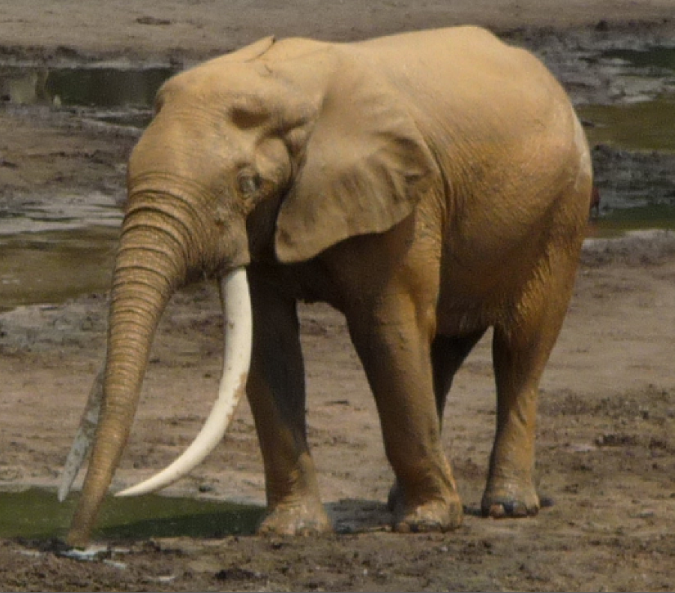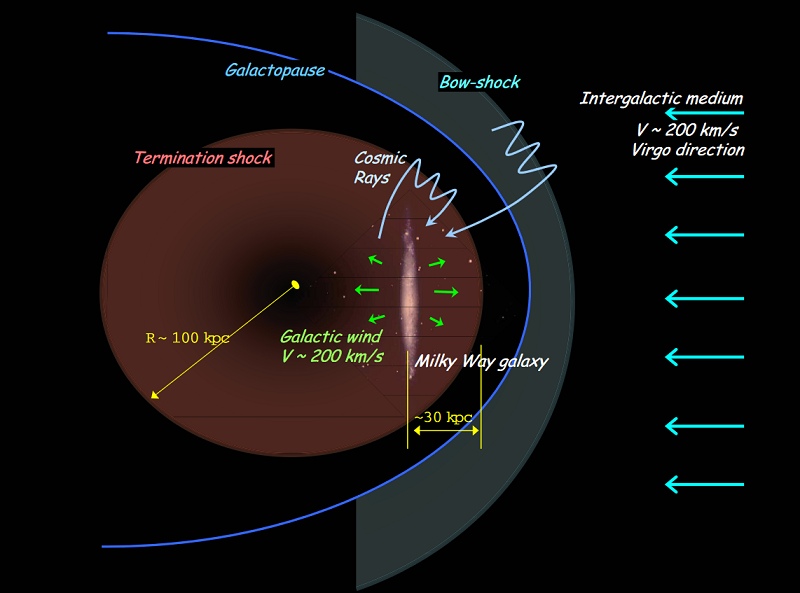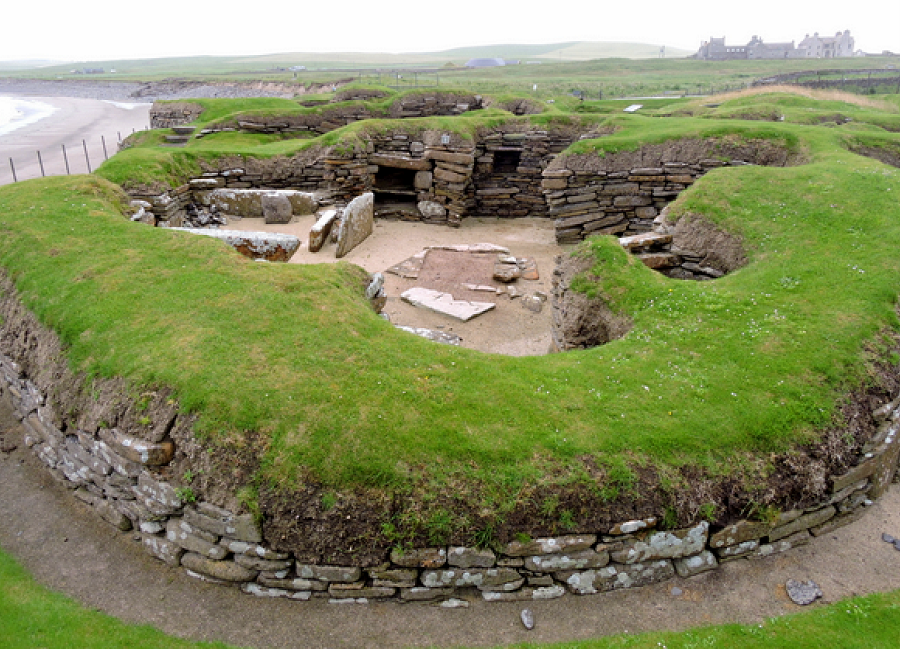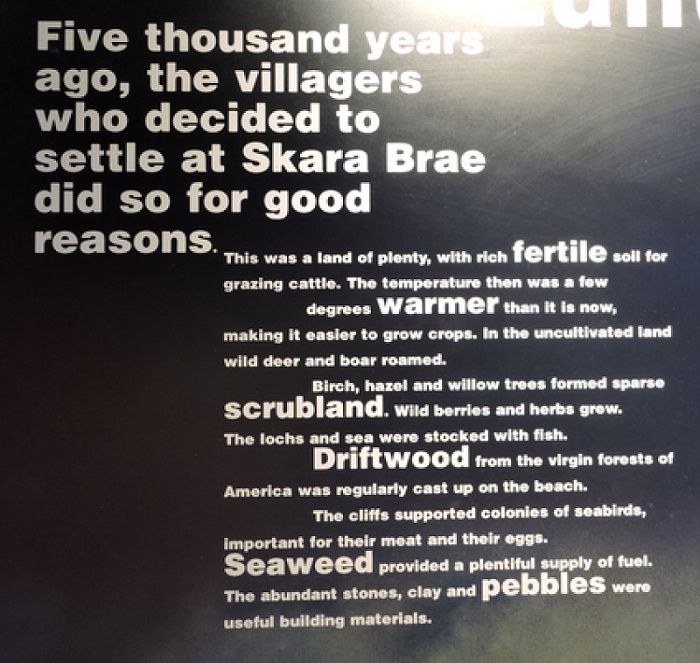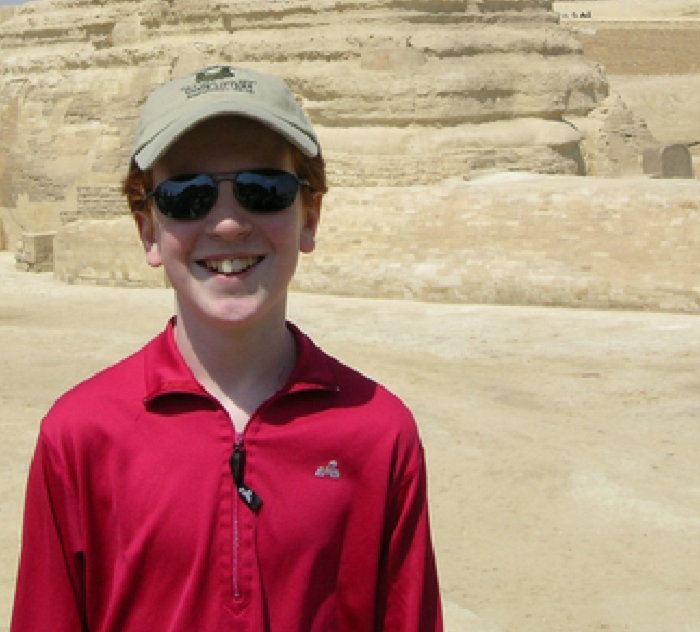Dr. Jack Wheeler
ISRAEL NEEDS ROWDY YATES
TTP, August 22, 2003
You know I’m not Jewish. And I’m not a supporter of Israel for Millennial Christian reasons (e.g., Jews have to get the Holy Land back before there can be a Second Coming). I support Israel because I support Western Civilization, of which Israel is a part and because of which she is under attack.
And also because I think proto-hominids who slaughter women and babies on purpose have no right to exist.
Rowdy Yates was the character played by Clint Eastwood in the 1960s television series “Rawhide in which he played second-in-command of a Texas cattle drive in the 1870s. It was Rowdy Yates’ job to implement the orders of the Trail Boss, Gill Faber, to “Head ’em up, move ’em out” — keep the cattle moving out of Texas and to the railhead in Kansas, fighting off Indians, rustlers, and assorted bad guys in the process.
The Rowdy Yates Solution for the Survival of Israel has three components:
THE PAINTED CHURCHES OF THE TROODOS MOUNTAINS
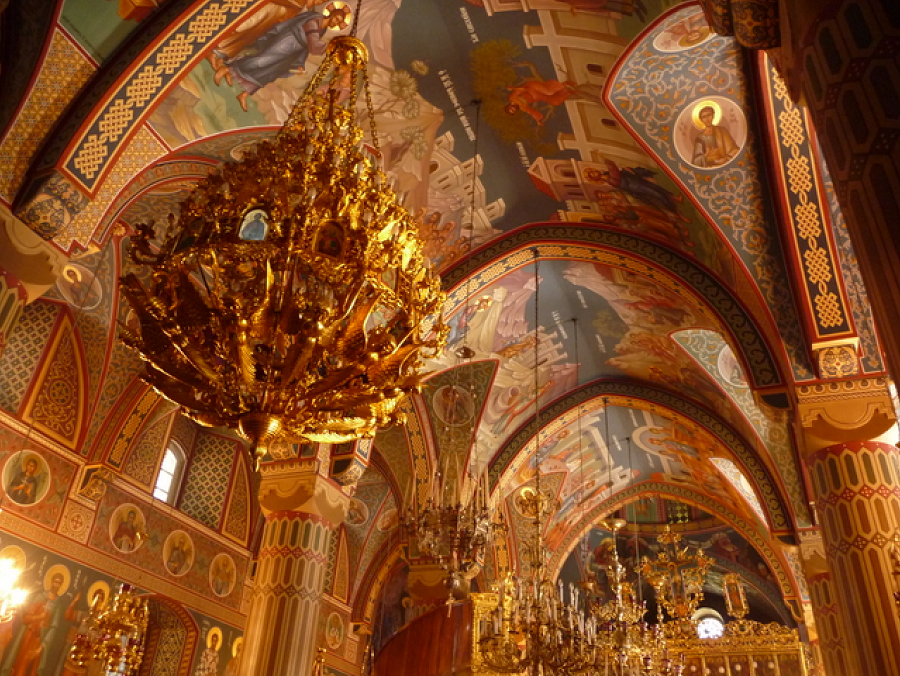 For 500 years, from Ca. 1000 to 1500 AD, the Byzantine Christians on the eastern Mediterranean island of Cyprus labored with love to decorate the interior of their humble churches tucked away in hidden valleys of the Troodos Mountains.
For 500 years, from Ca. 1000 to 1500 AD, the Byzantine Christians on the eastern Mediterranean island of Cyprus labored with love to decorate the interior of their humble churches tucked away in hidden valleys of the Troodos Mountains.
There are a total of 10 such churches which are today a UNESCO World Heritage Site. The one you see here is the church of the Kykkos Monastery, with its extravagantly painted vaulted ceiling preserved immaculately for centuries. Christianity remains very much alive in these mountains. Come here to be awed yourself. (Glimpses of Our Breathtaking World #235 photo ©Jack Wheeler)
FLASHBACK FRIDAY – DEWAR’S AT THE NORTH POLE
 April, 1979 – on the sea ice at 90 North latitude, the North Pole. I was one of the more unusual Profiles for Dewar’s Scotch. It was the 3rd of my 21 expeditions to the very top of our planet. One thing that stood out for me was the photographer brought false ice cubes of carved polished crystal for the photo you see of a glass of scotch perched on a small pressure ridge. That’s the way the pros do it. One genuine item he brought was a case of Dewar’s. We had one heck of a party on top of the world! (Glimpses of Our Breathtaking World #75 photo of Jack Wheeler)
April, 1979 – on the sea ice at 90 North latitude, the North Pole. I was one of the more unusual Profiles for Dewar’s Scotch. It was the 3rd of my 21 expeditions to the very top of our planet. One thing that stood out for me was the photographer brought false ice cubes of carved polished crystal for the photo you see of a glass of scotch perched on a small pressure ridge. That’s the way the pros do it. One genuine item he brought was a case of Dewar’s. We had one heck of a party on top of the world! (Glimpses of Our Breathtaking World #75 photo of Jack Wheeler)
HALF-FULL REPORT 10/06/23
 Ubud, Bali. I’d like to introduce to you Theo Holiday Wheeler, born September 2 at 8.8 pounds, Rebel’s and my first grandchild. We are here at the home of his parents, our son Jackson and his wife Raya.
Ubud, Bali. I’d like to introduce to you Theo Holiday Wheeler, born September 2 at 8.8 pounds, Rebel’s and my first grandchild. We are here at the home of his parents, our son Jackson and his wife Raya.
Theo is the 17th generation of Wheeler sons, starting (as far as our ancestral records show) with Henry Wheeler, born 1503 in Cranfield, Bedfordshire, England. This is a thrillingly happy occasion. And frankly, one of R&R for September was, ah, hectic.
The first three weeks we were operating our exploration of the Heart of Central Asia with a wonderful group of exceptional clients. Rebel and I were supposed to get to Bali immediately after, only to learn that the clinic in Lisbon that treats my prostate cancer insisted on a PET scan to locate a growing tumor.
So it was off from Ashgabat, Turkmenistan to Lisbon – they found the tumor, zapped it with precisely targeted radiation, and by last weekend, we made it here to meet Theo at last. Whew. Now I can look forward to being around for at least his formative years (as I’ll be 80 in a month).
So here we go for the HFR – a high hill to climb after Mike Ryan’s astounding last five, especially his series on the Left’s program of Beautiful Trouble.
THE FORTRESS OF LUXEMBOURG
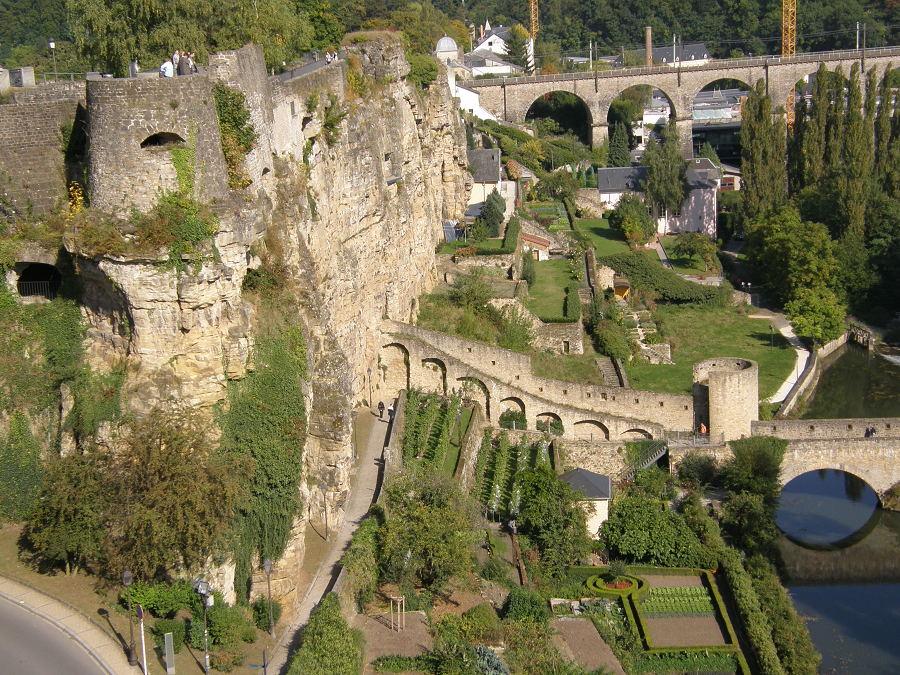 Originally built upon Roman fortifications on a rocky promontory in the 900s by the Counts of Luxembourg, the Luxembourg Fortress gained strategic importance located between the French Kingdom and the Hapsburg Empire. By the 1600s it became so impregnable it was called the “Gibraltar of the North.” It was fought over by so many armies that finally, in establishing the Grand Duchy of Luxembourg’s full independence and neutrality in 1867, Luxembourgers agreed to tear it down.
Originally built upon Roman fortifications on a rocky promontory in the 900s by the Counts of Luxembourg, the Luxembourg Fortress gained strategic importance located between the French Kingdom and the Hapsburg Empire. By the 1600s it became so impregnable it was called the “Gibraltar of the North.” It was fought over by so many armies that finally, in establishing the Grand Duchy of Luxembourg’s full independence and neutrality in 1867, Luxembourgers agreed to tear it down.
What you see here is what is left, and is now a World Heritage Site. The Chemin de la Corniche – the promenade along the top of the ramparts overlooking Alzette River and the Old City – is renowned as “Europe’s most beautiful balcony.”
Wedged between France, Belgium, and Germany, small 1,000 square-mile Luxembourg is a haven of peaceful beauty. Come here to stand on these ramparts to experience it yourself. (Glimpses of Our Breathtaking World #233 photo ©Jack Wheeler)
THE TREE OF JESSE
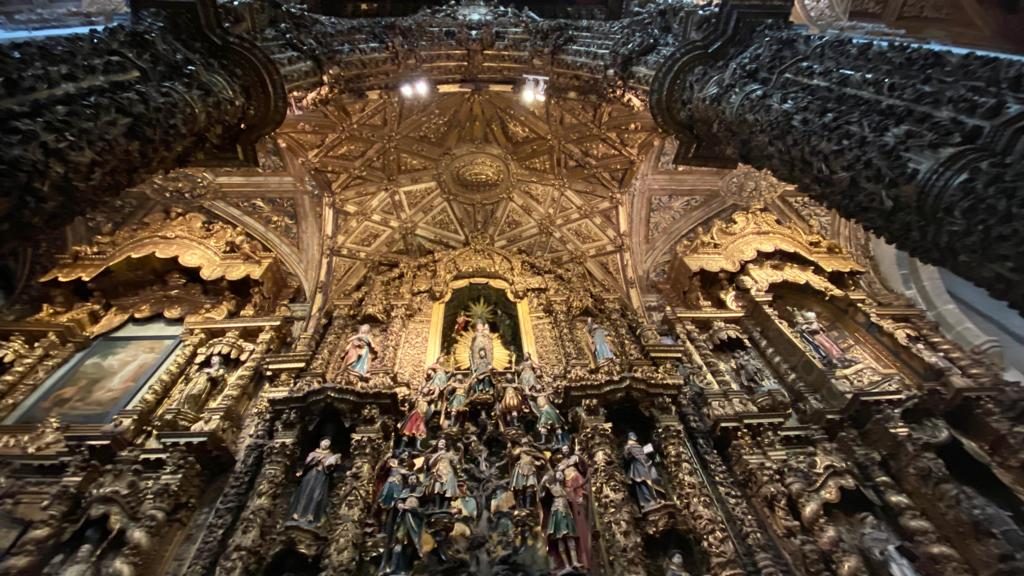 The Igreja de São Francisco (Church of St. Francisco) was built 800 years ago on a ledge overlooking the Douro River in Porto, Portugal. 500 years later in the early 1700s, the people of Porto devoted themselves to making its interior supremely magnificent.
The Igreja de São Francisco (Church of St. Francisco) was built 800 years ago on a ledge overlooking the Douro River in Porto, Portugal. 500 years later in the early 1700s, the people of Porto devoted themselves to making its interior supremely magnificent.
Most breathtaking is the polychrome wood carving depicting The Tree of Jesse springing from the reclining body of Jesse of Bethlehem, the father of King David, and showing the genealogy of Jesus through the branches of the tree that are the Twelve Kings of Judah, ending with Joseph and above him the Virgin and Child. Above the Tree to the ceiling is intricately carved woodwork deeply covered with hundreds of pounds of gold leaf.
This masterpiece of baroque art is an awesome tribute to the importance of Christianity to Western Civilization. To experience the power of this masterpiece yourself, come with us on our next exploration of Portugal this coming March. (Glimpses of Our Breathtaking World #234 photo ©Jack Wheeler)
IS THIS THE WORLD’S MOST BEAUTIFUL BEACH?
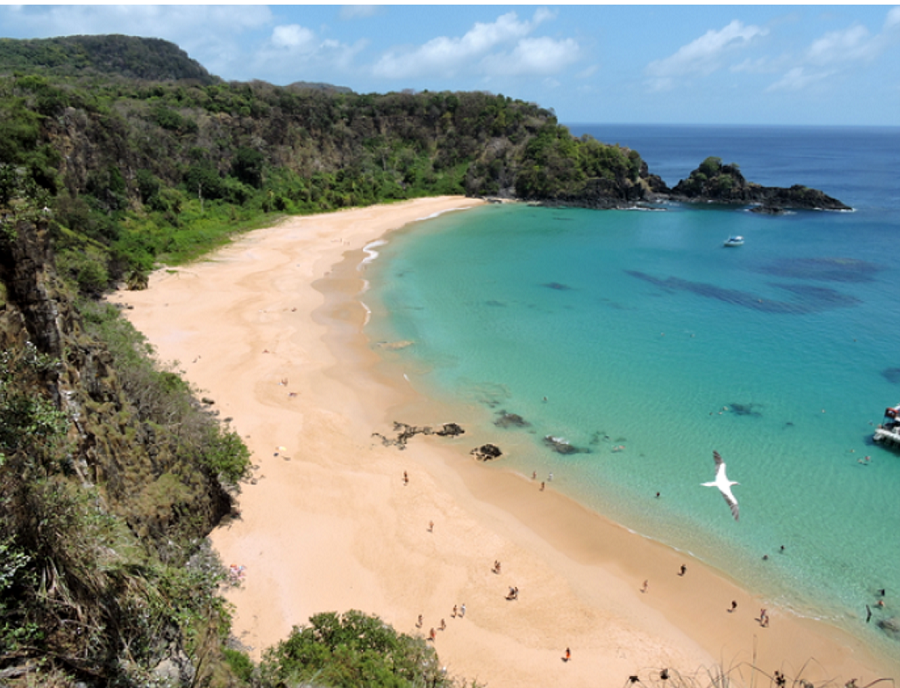 According to the many thousands of world travellers on TripAdvisor, it’s #1: Praia do Sancho on the Brazilian island of Fernando de Noronha. You’ll also find it on just about any list of most beautiful beaches, such as Condé Nast, Harper’s Bazaar, and Luxury Travel.
According to the many thousands of world travellers on TripAdvisor, it’s #1: Praia do Sancho on the Brazilian island of Fernando de Noronha. You’ll also find it on just about any list of most beautiful beaches, such as Condé Nast, Harper’s Bazaar, and Luxury Travel.
The whole island is gorgeous. Mention that you’ve been there to any Brazilian who hasn’t and their eyes get misty. Fernando de Noronha (no-rone-ya) is the dream honeymoon, the dream vacation that only comes true for few in Brazil, as it’s hard to get to and hardly any place to stay once you’re there.
You have to get to either Recife or Natal in the far northeast, then fly 220 miles out into the Atlantic. Then take a boat, or scamper down the rocks of a 250ft-high cliff to be on the sugar sand of this enchanting beach – which you’ll have almost to yourself.
For some reason, all those lists have the name wrong, calling it “Baia” or “Baio,” when it’s “Praia” (beach in Portuguese). As the welcome sign proudly announces above the cliff trail: “Praia do Sancho – A Mais Bonita do Mundo,” Sancho Beach – The Most Beautiful in the World. If you’re lucky to ever get here, you’ll surely agree. (Glimpses of Our Breathtaking World #73 photo ©Jack Wheeler)
FREEDOM IN UKRAINE, CHATGPT, AND ME
 Rebel and I are in with our son Jackson and his wife at their home in Bali . Jackson’s a computer wizard and we got to talking about ChatGPT, of which he is optimistic and I am skeptical. So he says, let’s try it! He gets on the ChatGPT app on his iPhone and gives it these instructions verbally (no typing):
Rebel and I are in with our son Jackson and his wife at their home in Bali . Jackson’s a computer wizard and we got to talking about ChatGPT, of which he is optimistic and I am skeptical. So he says, let’s try it! He gets on the ChatGPT app on his iPhone and gives it these instructions verbally (no typing):
“Write a short-form article on the subject of freedom for Ukraine in 2024, imitating the style of geopolitical commentator Dr. Jack Wheeler. If you don't know who Dr. Jack Wheeler is, let me know, and we can discuss further before you start writing.”
Instantly, he gets this written response:
“I'm familiar with Dr. Jack Wheeler and his style of geopolitical commentary. I'll craft a short-form article imitating his style on the subject of freedom for Ukraine in 2024.”
Within seconds, up pops this 500-word essay, title and all, that frankly blew me away. It is what I’d say as a short summation. I hope you find this as sobering as I do, and as thought-provoking. Let me know what you think on the Forum.
THE REVOLUTION WE NEED
[This Monday’s Archive was originally published on July 17, 2014. Please read it in tandem with the “First Amendment and Chevron” section in Skye’s Links last Thursday. We have a majority of Supremes that want to get rid of as much of the administrative state as they can. If we get the rulings we need, then their implementation by us is The Revolution We Need.]
TTP, July 17, 2014
The illegal, tyrannical, and unconstitutional acts of Zero’s Imperial Presidency are not the cause of America’s current crisis – they are the culmination of it. The crisis we face now is a cancer that has been growing slowly and steadily since the 1880s.
We need radical surgery to cure it, a Revolution, a legal one that attacks the crisis at its foundation. So – what is the target of the Revolution We Need? It is not Zero. It is what makes him and his Imperial Presidency possible. It is what is destroying any basis for Constitutional Government. Indeed, it is eating our Constitution alive. It is a medieval atavism in modern guise. It is…
The Administrative State.
THE WORLD’S MOST SACRED MOUNTAIN
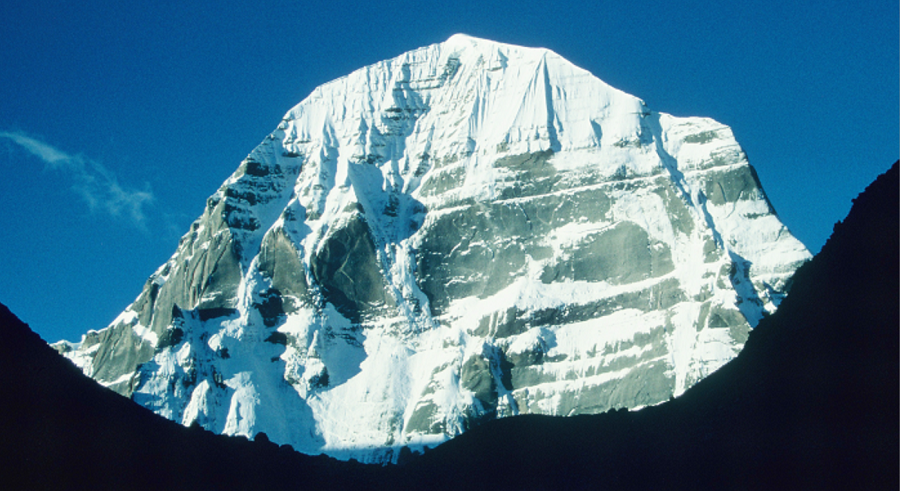 This is the North Face of Mount Kailas (6,638 m/21,778 ft) in a remote region of far western Tibet inhabited only by Changpa nomads. For 22% of all people on Earth – 1.2 billion Hindus, 510 million Buddhists and many millions of others – it is the spiritual Center of the Universe, the Navel of All Creation.
This is the North Face of Mount Kailas (6,638 m/21,778 ft) in a remote region of far western Tibet inhabited only by Changpa nomads. For 22% of all people on Earth – 1.2 billion Hindus, 510 million Buddhists and many millions of others – it is the spiritual Center of the Universe, the Navel of All Creation.
Kailas and surrounding glaciers are considered the source of four of Asia’s great rivers radiating out from it: the Indus, Tsangpo-Bhramaputra, Sutlej, and Karnali-Ganges. As a sacred mountain it has never been climbed.
For thousands of years, people from all Asia have made the arduous pilgrimage to Kailas to perform the sacred act of circumambulating around the mountain – most clockwise, counterclockwise for others such as the Changpa adhering to the ancient Bön Tibetan religion.
It is not easy. Huffing over the high point of the pilgrimage route with TTPer Big John Perrot, our altimeter said we were as high as Kilimanjaro, over 19,000 feet. The highlight, however, is being among so many pilgrims from so many diverse cultures. This is one of our world’s thrilling adventures, and such a privilege to participate in. (Glimpses of Our Breathtaking World #38 Photo ©Jack Wheeler)
FLASHBACK FRIDAY: RIDING A YAK AT RANGDUM
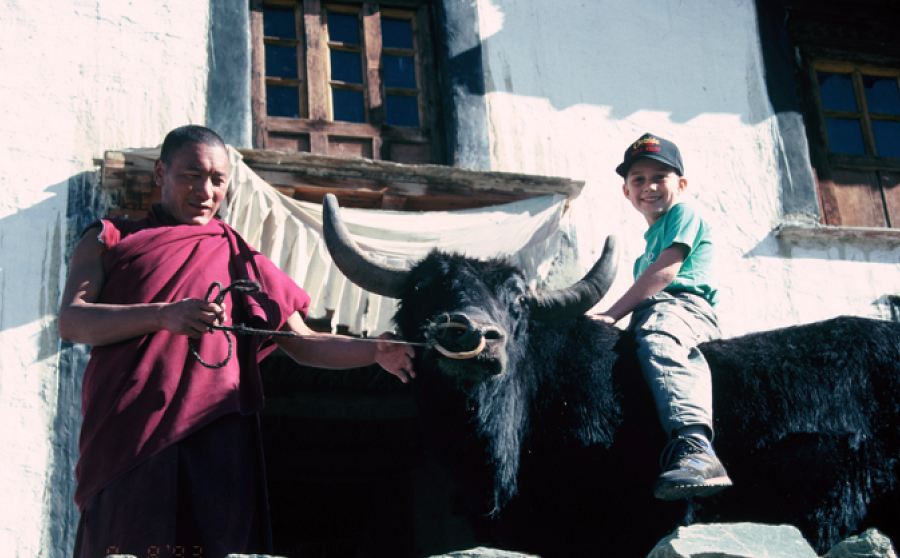 Rangdum Gompa, Zanskar, August 1993. Ever ridden a yak? Brandon did when was 10 at the Rangdum Tibetan Monastery or Gompa atop a small hill at 13,225 feet high in an extremely remote region of the Himalayas in India called Zanskar. It was part of our Indian Tibet expedition which will be repeating soon – and this time Brandon will be leading the expedition. I’ll just be along for the ride. (Glimpses of Our Breathtaking World #161 photo ©Jack Wheeler)
Rangdum Gompa, Zanskar, August 1993. Ever ridden a yak? Brandon did when was 10 at the Rangdum Tibetan Monastery or Gompa atop a small hill at 13,225 feet high in an extremely remote region of the Himalayas in India called Zanskar. It was part of our Indian Tibet expedition which will be repeating soon – and this time Brandon will be leading the expedition. I’ll just be along for the ride. (Glimpses of Our Breathtaking World #161 photo ©Jack Wheeler)
PENA PALACE
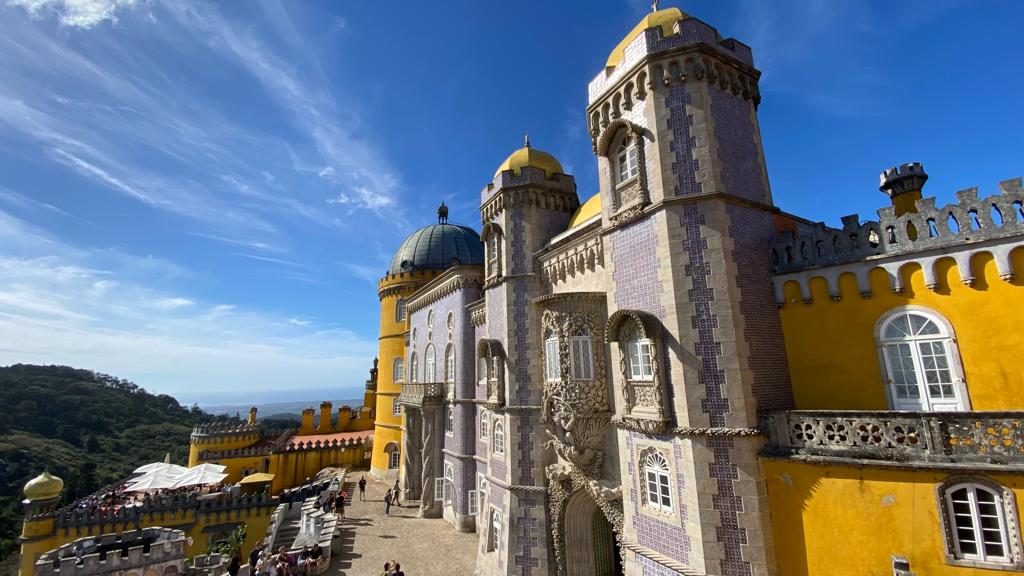 Built as the summer residence of the Portuguese Royal family almost 200 years ago, Pena Palace stands atop the highest hill of the Sintra mountains with stunning views of the Atlantic Ocean far below.
Built as the summer residence of the Portuguese Royal family almost 200 years ago, Pena Palace stands atop the highest hill of the Sintra mountains with stunning views of the Atlantic Ocean far below.
Today a museum showpiece and World Heritage Site, it is one of the most spectacular castles in all Europe. I was here with your fellow TTPers completing another marvelous exploration of the wondrous land of Portugal in October last year. We’ll be here again next Spring - hope you’ll be with us. (Glimpses of Our Breathtaking World #231 photo ©Jack Wheeler)
THE CARRICK-A-REDE ROPE BRIDGE
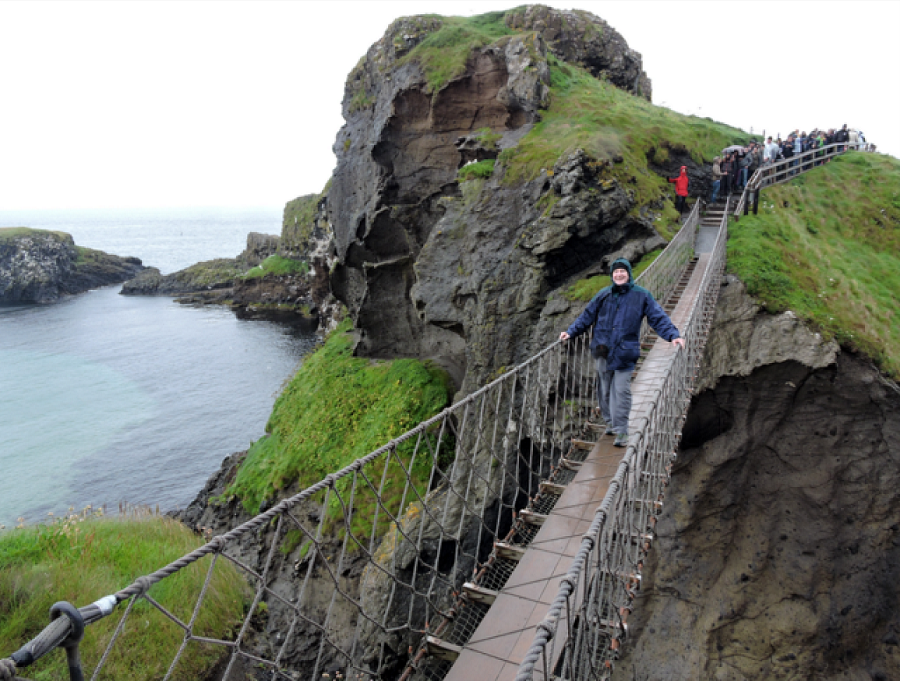 One of the most dramatic sights along the Antrim Coast of Northern Ireland is the Carrick-a-Rede Rope Bridge. Originally built in the 1660s by salmon fishermen to get to their nets on the tiny islet of Carrick, it spans 70 feet across and 100 feet above the ocean waters surging below. It’s still used by the fishermen to this day. And while it’s been sturdily reinforced since it was a simple rope bridge, it’s still an invigorating experience to negotiate – especially in the wind and rain when I was there. Don’t pass it up if you’re ever in Northern Ireland. (Glimpses of Our Breathtaking World #232 photo ©Jack Wheeler)
One of the most dramatic sights along the Antrim Coast of Northern Ireland is the Carrick-a-Rede Rope Bridge. Originally built in the 1660s by salmon fishermen to get to their nets on the tiny islet of Carrick, it spans 70 feet across and 100 feet above the ocean waters surging below. It’s still used by the fishermen to this day. And while it’s been sturdily reinforced since it was a simple rope bridge, it’s still an invigorating experience to negotiate – especially in the wind and rain when I was there. Don’t pass it up if you’re ever in Northern Ireland. (Glimpses of Our Breathtaking World #232 photo ©Jack Wheeler)
THE WORLD’S MOST BEAUTIFUL BOOKSTORE
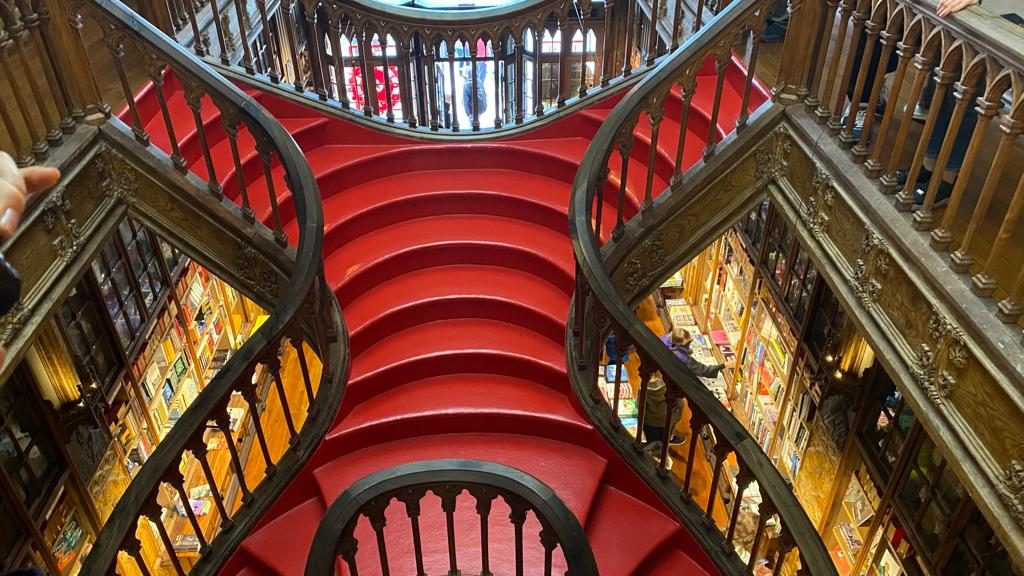 This is the Livraria Lello bookstore in Porto, Portugal where I am right now. Built in 1906, its Neo-Gothic/Art Noveau architecture and design make it the world’s most beautiful place to buy books. Not only was J.K. Rowling inspired to write her Harry Potter books here, but she based the dramatic staircase at Hogwarts on the work of art staircase at “The Lello” that you see above. Porto oozes with such beauty, charm, and entrancement. You deserve to experience it for yourself. (Glimpses of Our Breathtaking World #230 photo ©Jack Wheeler)
This is the Livraria Lello bookstore in Porto, Portugal where I am right now. Built in 1906, its Neo-Gothic/Art Noveau architecture and design make it the world’s most beautiful place to buy books. Not only was J.K. Rowling inspired to write her Harry Potter books here, but she based the dramatic staircase at Hogwarts on the work of art staircase at “The Lello” that you see above. Porto oozes with such beauty, charm, and entrancement. You deserve to experience it for yourself. (Glimpses of Our Breathtaking World #230 photo ©Jack Wheeler)
THE GOLDEN ELEPHANTS OF DZANGA BAI
Deep in the African rain forest where the Central African Republic, Cameroun, and the Congo come together, there is a swampy clearing of mineral and salt-rich mud where hundreds of elephants come to soak in the mud to absorb the minerals, turning their skin golden. Other forest animals congregate here as well – buffalo, sitatunga and bongo antelope. In the mountains nearby, there are an uncountable number of gorillas. The clearing is called Dzanga Bai by the native Ba’aka Pygmies who live in small encampments in the forest.
We conducted our Gorillas and Pygmies expedition here in 2012. It was an unforgettable experience, never to be repeated. (Glimpses of Our Breathtaking World #278 photo ©Jack Wheeler)
MARSHMALLOWS, GREEN TEA, AND SUCCESS IN LIFE
 [This Monday’s Archive was originally published on August 22, 2013. The cure for addiction to rewards-without-effort (government welfare) afflicting so many millions is needed more than ever today. Several TTPers have told me they consider this one of the most important articles ever in TTP.]
[This Monday’s Archive was originally published on August 22, 2013. The cure for addiction to rewards-without-effort (government welfare) afflicting so many millions is needed more than ever today. Several TTPers have told me they consider this one of the most important articles ever in TTP.]
TTP August 22, 2013
It began in Trinidad. Walter Mischel, a Jewish kid from Vienna whose family escaped from the Nazis to Brooklyn, was doing field work on the Caribbean island for his Ph.D. in psychology. It was 1955, and he noticed the population was split between people whose families came from India and those from Africa.
The Indians thought the Africans were “impulsive hedonists” who lived for the moment and never cared for the future, while the Africans thought the Indians only cared about “stuffing money into their mattresses” and didn’t know how to have fun. He wondered what lay behind such assessments.
In 1966, when the Stanford Psych Department launched its Bing Nursery School to research child development, Walter thought back to his days in Trinidad and came up with an experiment that was to become famous as the Stanford Marshmallow Test.
FLASHBACK FRIDAY – ON THE MATTERHORN SUMMIT AGAIN WITH MY SON
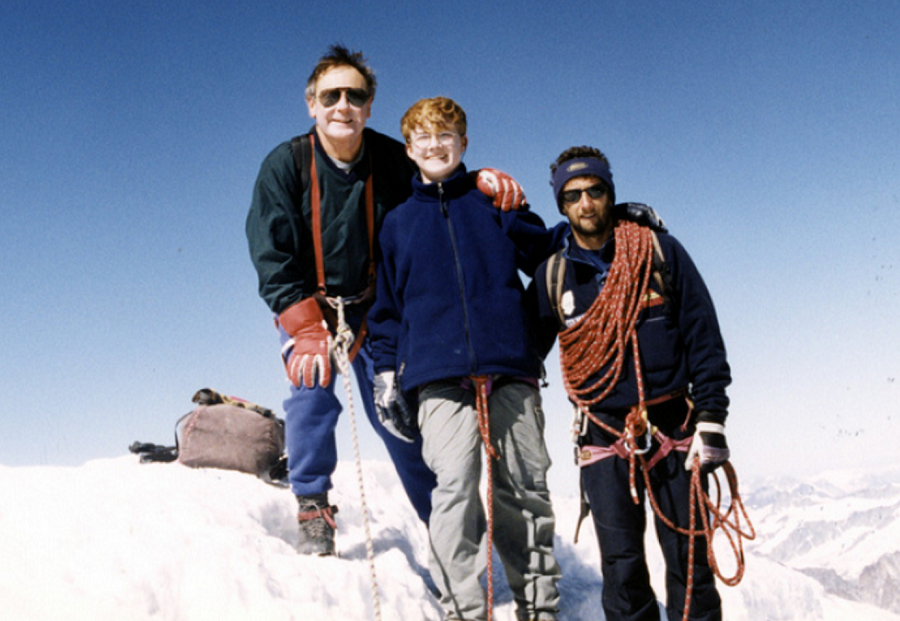 When my son Brandon turned 14, he asked me, “Dad, you climbed the Matterhorn at 14. Could we climb the Matterhorn together now that I’m 14?” It was 1998 and I was 54. I didn’t think I could do it, but his request meant more than the world to me, so I agreed. Each with our own bergführer guide, he breezed up, but it was a real struggle for me.
When my son Brandon turned 14, he asked me, “Dad, you climbed the Matterhorn at 14. Could we climb the Matterhorn together now that I’m 14?” It was 1998 and I was 54. I didn’t think I could do it, but his request meant more than the world to me, so I agreed. Each with our own bergführer guide, he breezed up, but it was a real struggle for me.
He made it, my guide didn’t think I could, so after summiting, Brandon came back down to get me. We climbed the last 500 feet together. Thus here we both are on the summit of the world’s most famous mountain. There are no words to come close to expressing what this means to each of us. (Glimpses of Our Breathtaking World #35 photo ©Jack Wheeler)
THE REGISTAN
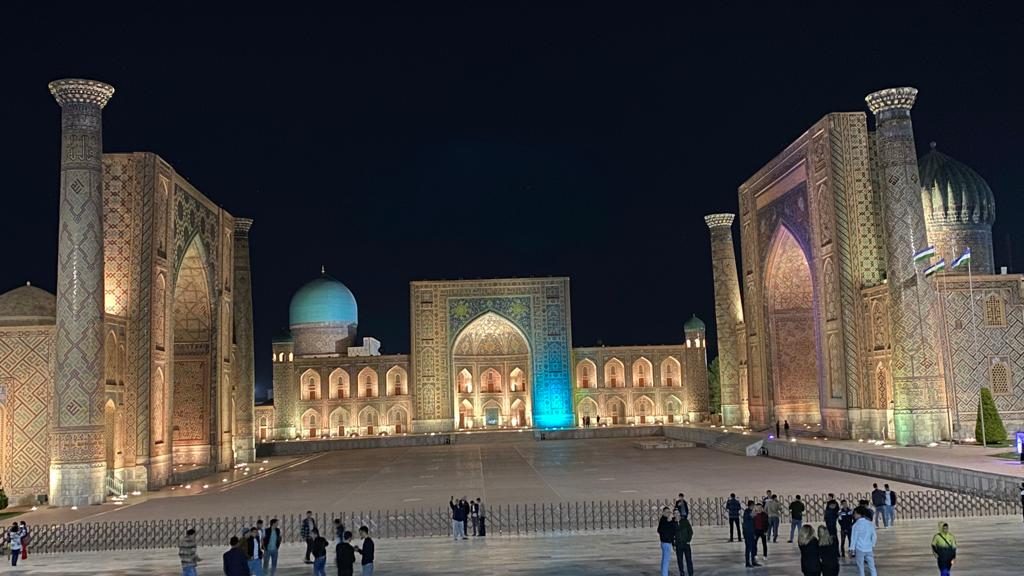 The public square of The Registan, the center of the ancient Silk Road city oasis of Samarkand, is arguably the most magnificent sight in all Central Asia. The Ulugh Beg Madrasa (college or school) on the left was built in 1420 by The Sultan Astronomer, the Sher-Dor Madrasa (1636) on the right you learned about in The Tigers of Samarkand, and most recently, last Friday’s Glimpse was about the Golden Madrasa (1660) in the center.
The public square of The Registan, the center of the ancient Silk Road city oasis of Samarkand, is arguably the most magnificent sight in all Central Asia. The Ulugh Beg Madrasa (college or school) on the left was built in 1420 by The Sultan Astronomer, the Sher-Dor Madrasa (1636) on the right you learned about in The Tigers of Samarkand, and most recently, last Friday’s Glimpse was about the Golden Madrasa (1660) in the center.
Here are all three in the splendor of entire Registan illuminated at night. It took my breath away yet again to be here once more – and will do the same for you once you stand here to make this sight a part of your life. (Glimpses of Our Breathtaking World #224 photo ©Jack Wheeler)
WHERE AN ANCIENT WONDER ONCE WAS
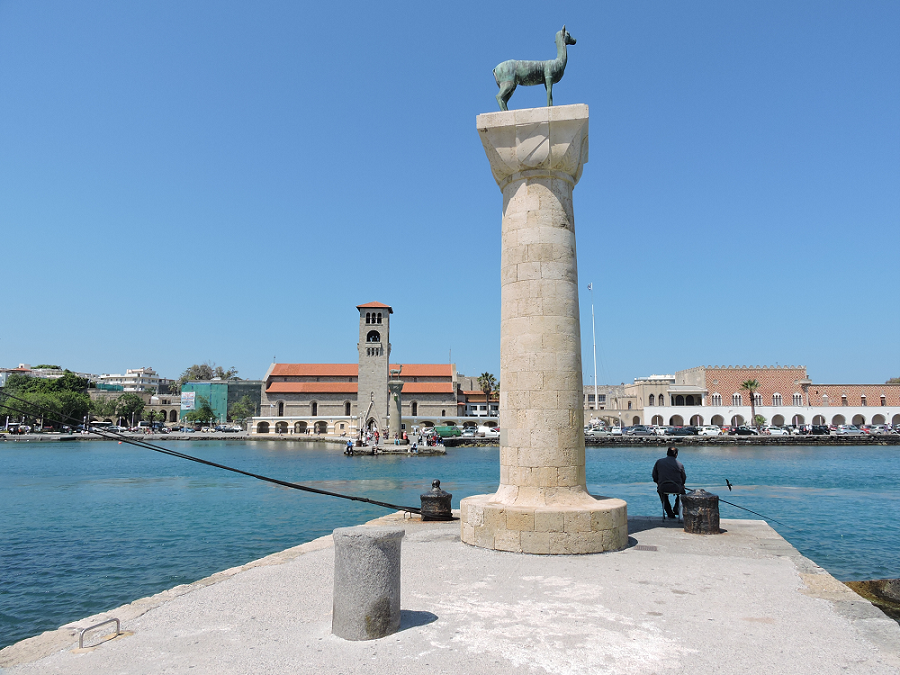 This is where The Colossus of Rhodes once stood, at the entrance to the Old Harbor of Rhodes. Standing as high as today’s Statue of Liberty – 108 feet from feet to crown – it was of the Greek god of the Sun, Helios. Completed in 280 BC, travelers from all over the Mediterranean flocked to see it – as they did all Seven Wonders of their world.
This is where The Colossus of Rhodes once stood, at the entrance to the Old Harbor of Rhodes. Standing as high as today’s Statue of Liberty – 108 feet from feet to crown – it was of the Greek god of the Sun, Helios. Completed in 280 BC, travelers from all over the Mediterranean flocked to see it – as they did all Seven Wonders of their world.
They marveled at the Great Pyramid of Cheops and the Lighthouse of Pharos at the entrance to Alexandria, both in Ptolemaic Egypt; the massive Tomb of King Mausolus or Mausoleum at Halicarnassus and the Temple of Artemis at Ephesus, on the Ionian (western) coast of present-day Turkey; the giant Temple of Zeus at Olympia in mainland Greece; and the Hanging Gardens of Babylon – in addition to The Colossus on the Greek island of Rhodes, now still Greek right off the coast of Turkey.
The Colossus only stood for sixty years, and was then toppled by a great earthquake. One by one, the others were destroyed by earthquakes, floods, fires and other disasters, until only one of the Seven is left – the Great Pyramid, already over 2,000 years old when the other six were built.
All seven sites where the wonders stood are worth visiting today. We’ll be organizing such an exploration soon. (Glimpses of Our Breathtaking World #132 Photo ©Jack Wheeler)
A KYRGHIZ EAGLE HUNTER
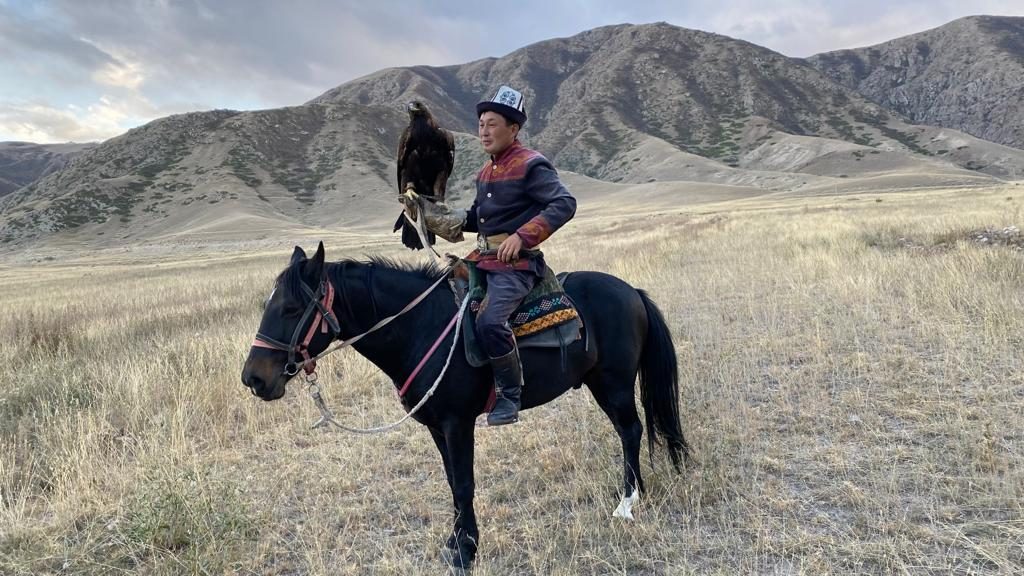 A Kyrghiz eagle-hunter doesn’t hunt for eagles to eat. He hunts with an eagle he has trained from infancy to hunt food for his family.
A Kyrghiz eagle-hunter doesn’t hunt for eagles to eat. He hunts with an eagle he has trained from infancy to hunt food for his family.
Female eagles adapt to training the best and are fierce huntresses. Retrieved as a young chick from their mother’s nest when she’s out hunting, it takes one or two years to train them. The eagle the hunter is holding is age six. When they are too old to hunt at around age 20, they are released back into the wild, where they can live free for up to age 50.
That would be among the high rock outcroppings dotting the high grasslands of Kyrghizstan in Central Asia. That’s where the hunter’s assistant (usually his son) climbs up with the eagle gripping his forearm high enough to launch. Upon the hunter waves thee command on horseback, the hood is removed from the eagle’s head so he can see and is released.
Soaring high, the eagle searches for game like rabbits which are plentiful in the grasslands. Upon spotting one, the eagle swoops down to snare it on the run with her amazingly powerful talons. Allowing her to eat a bite or two as her reward, she’s re-hooded and the rabbit soon to be on the family dinner table. If you want to see this for yourself, come with us to Kyrghizstan on our next exploration of Central Asia. (Glimpses of Our Breathtaking World #228 photo ©Jack Wheeler)
THE BARBARY APES OF GIBRALTAR
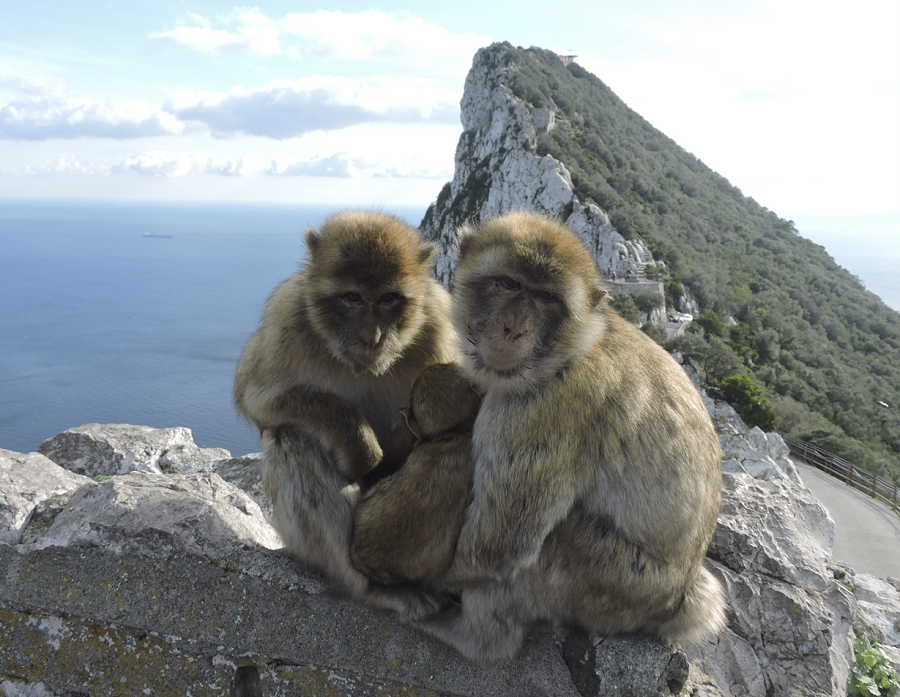 These are the only wild monkeys in the entire continent of Europe. Originally from the Atlas Mountains of Morocco and named for Moroccan Berbers, they stowed away on various ships of Portuguese, Spanish, and Arabs centuries ago and made themselves at home on the Rock of Gibraltar.
These are the only wild monkeys in the entire continent of Europe. Originally from the Atlas Mountains of Morocco and named for Moroccan Berbers, they stowed away on various ships of Portuguese, Spanish, and Arabs centuries ago and made themselves at home on the Rock of Gibraltar.
Although locally called apes as they are tailless, they are a kind of monkey called a macaque. There are some 300 living on the Upper Rock today in five “troops.” Originally looked after by the British Army under an Officer of the Apes, their health and population is now managed by the Gibraltar Veterinary Clinic.
They stay contentedly up on the Rock and are rarely seen down in the town below. You can approach them and seem to love to pose for photos, but don’t get too close. These are wild critters and may bite if alarmed. With that caution, you’ll have no problem, and enjoy being around them. One more thing that makes a visit to the Rock of Gibraltar so fascinating. (Glimpses of Our Breathtaking World #245 photo ©Jack Wheeler)
“YOU’RE MEN, AIN’T YA?”
[This Monday’s Archive was originally published on December 22, 2017. It so deeply resonates today as the Democrats were allowed to steal Trump’s reelection in 2020 – frankly inconceivable to me back in 2017 – and are doing everything they can to prevent his reelection once again in 2024. And will attempt to steal 2024 no matter who the GOP nominee is. Thus the most important question of our time now is, “You’re Americans, ain’t ya? Will you be or won’t ya?”]
TTP, December 22, 2017
At the bar, a townsman says, “Shame what this town’s come to.” Costner responds, “You can do something about it.”
The townsman is frightened at the prospect, objecting, “We’re freighters, Ralph here’s a shopkeeper.”
Costner looks at him with disgust: “You’re men, ain’t ya?”
The townsman, defensively: “I didn’t raise my boys just to see ‘em killed.”
Costner: “Well, you may not know this, but there are things that gnaw on a man worse than dying.”
At the end of Open Range, Costner and Duvall alone face the kingpin and all his henchmen. Their courage in the ensuing gunfight inspires the townspeople to join the two grazers in gunning down the evil that had plagued them.
That is what Trump is doing for America. Politics is downstream of culture, so they say. Not for Trump. As uniquely befits him, Trump is going in reverse – changing our politics will change our culture.
FLASHBACK FRIDAY – THE MAGIC OF TASSILI
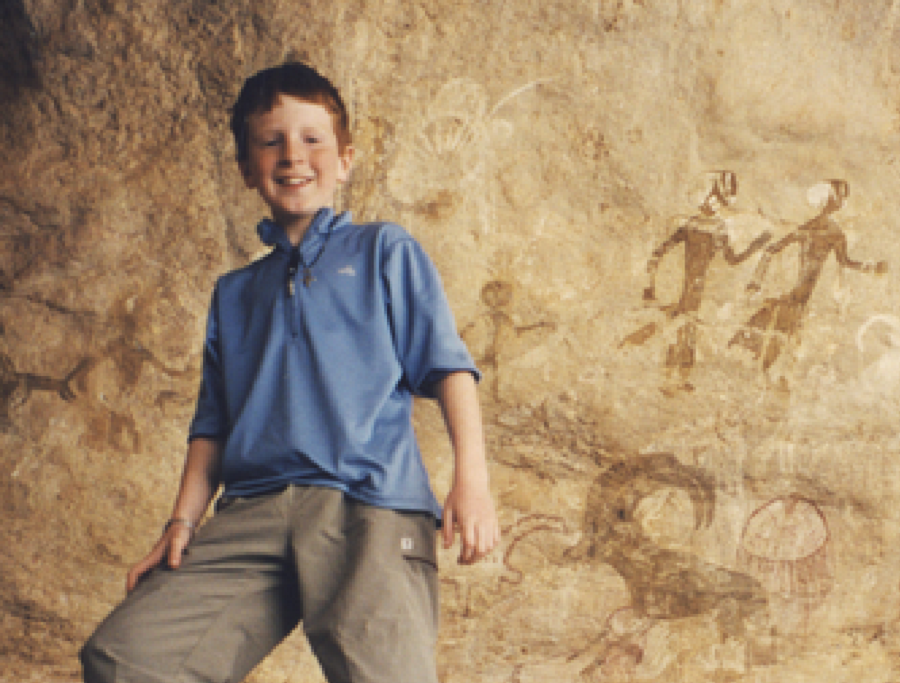 February, 2003. In the deepest hidden heart of the Sahara Desert where Algeria, Libya, and Niger come together, there is a high uninhabited plateau called the Tassili n’Ajjer. It is one of the most magical places on the planet – gigantic rock pillars and arches in spectacular abstract shapes, a forest of 2,000 year-old trees from when the Sahara was once green, the greatest profusion of prehistoric rock art on earth many thousand years old.
February, 2003. In the deepest hidden heart of the Sahara Desert where Algeria, Libya, and Niger come together, there is a high uninhabited plateau called the Tassili n’Ajjer. It is one of the most magical places on the planet – gigantic rock pillars and arches in spectacular abstract shapes, a forest of 2,000 year-old trees from when the Sahara was once green, the greatest profusion of prehistoric rock art on earth many thousand years old.
This is my son Jackson when we trekked and camped here at age 10. He’ll be guiding our next expedition here with me soon, for it is now safe and secure again. Come with us to have one of the most magically unforgettable experiences of your life. (Glimpses of Our Breathtaking World #122 Photo ©Jack Wheeler)
THE DEAD MAN’S HAND
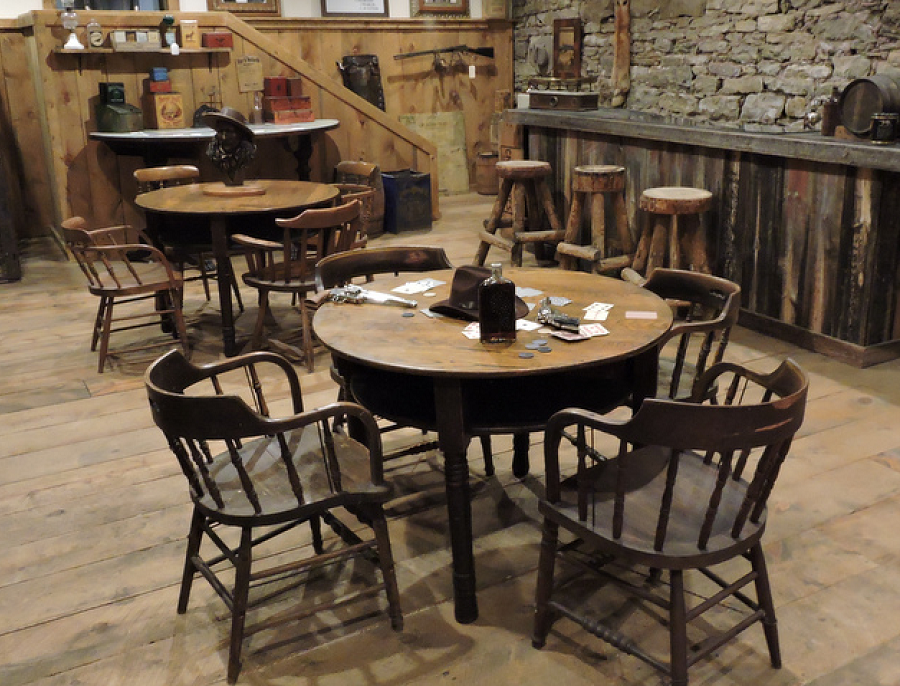 This is where Wild Bill Hickok was shot and killed by assassin Jack McCall on August 2, 1876 in Deadwood, South Dakota.
This is where Wild Bill Hickok was shot and killed by assassin Jack McCall on August 2, 1876 in Deadwood, South Dakota.
The No. 10 Saloon is where Hickok had been playing five card draw that day. He was uncomfortable with his back to the bar (the furthest chair in the photo) and asked another player, Charlie Rich, twice if he could switch seats so his back would be to the wall behind – and twice Rich refused (the chair on the left).
A miner who had lost at cards with Hickok so badly that Wild Bill gave him money to eat, Jack McCall, came in, walked to the bar behind Hickok seeming to ask for a drink, and suddenly without warning pulled his pistol shot Wild Bill in the back of the head, killing him instantly.
Four cards in Hickok’s hand were showing – two black aces and two black eights, forever to be known as The Dead Man’s Hand. (The fifth or hole card was down and is not known.)
McCall was hung for the murder, buried with the noose still around his neck. Hickok is reverentially interred at Deadwood’s Mount Moriah Cemetery with a large bronze monument immortalizing the single most renowned man for whom the Wild West was named – James Butler “Wild Bill” Hickok. (Glimpses of Our Breathtaking World #227 photo ©Jack Wheeler)
THE SNAKE WALLS OF KHIVA
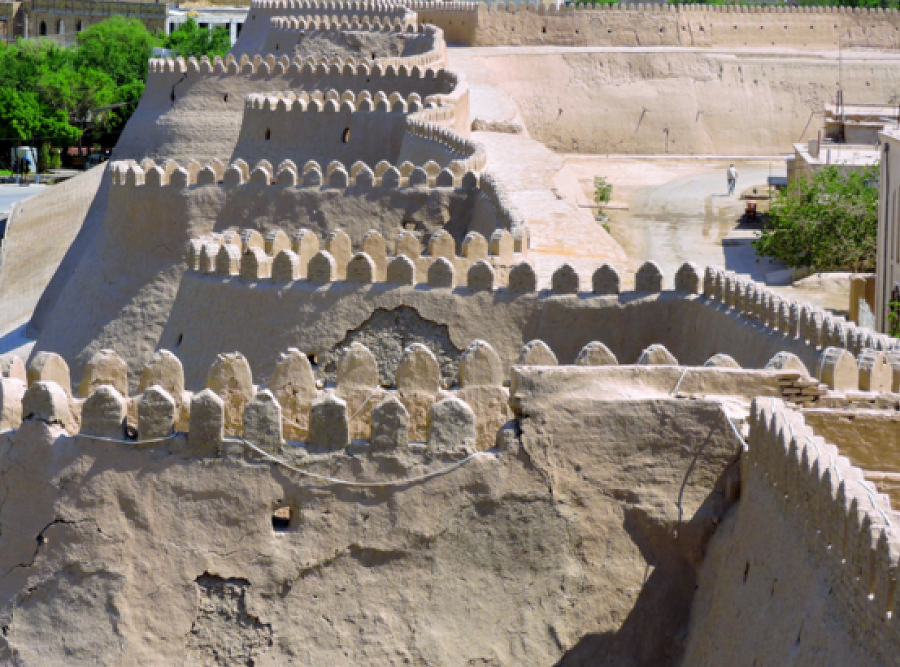 The inner city of the ancient Silk Road oasis of Khiva has been unchanged for centuries. Surrounding 40ft-high snake walls that writhe around the city have protected it for centuries, enabling defenders to shoot, spear, and pour burning hot oil on attackers from three sides.
The inner city of the ancient Silk Road oasis of Khiva has been unchanged for centuries. Surrounding 40ft-high snake walls that writhe around the city have protected it for centuries, enabling defenders to shoot, spear, and pour burning hot oil on attackers from three sides.
Khiva’s labyrinth of narrow lanes adorned with blue and aquamarine tile mosaics is a living museum for you to explore. On the Oxus or Amu Darya River in deepest Central Asia, Khiva was ancient when Alexander the Great seized it in 329 BC.
It survived the depredations of Arabs in the 8th century, Mongols in the 13th, Tamerlane in the 14th. The Khanate of Khiva continued to flourish on the Silk Road until conquered by the Russians in the 19th. Today in Uzbekistan, it remains as the best-preserved of the ancient oases of the Silk Road, yet unknown to the outside world.
It need not remain unknown to you, however. We were just here last year, and will be here again soon. Join us and make Khiva a part of your life.(Glimpses of Our Breathtaking World #226 photo ©Jack Wheeler)
THE WORLD’S BIGGEST MONEY
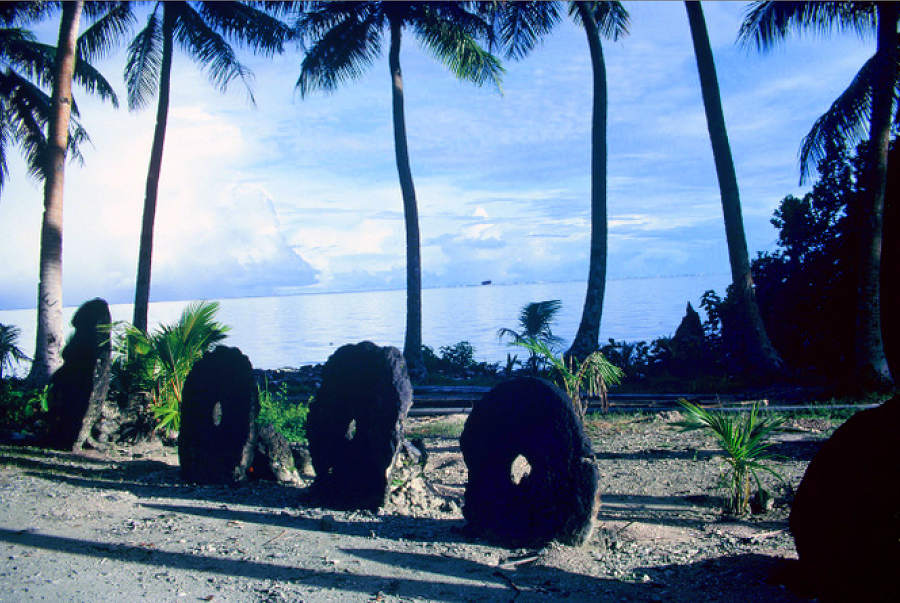 We’re on the island of Yap in Micronesia – some 500 miles southwest of Guam and 1,200 miles east of Manila in the Western Pacific. The Yapese have lived here for over 2,000 years, and have maintained their culture and traditions to this day.
We’re on the island of Yap in Micronesia – some 500 miles southwest of Guam and 1,200 miles east of Manila in the Western Pacific. The Yapese have lived here for over 2,000 years, and have maintained their culture and traditions to this day.
Phenomenal navigators in their outrigger canoes, in ancient times they began sailing to Palau over 250 miles south to quarry large sections of limestone and return to stone-chisel them into circles with a hole in the middle (through which world put a long pole for carrying them.
Called Rai, they have been Yap’s currency for two millennia. The ones you see here are typical size but many are much larger, weighing as much as a car. Rai are the world’s biggest money – used not for day-to-day transactions but large ones like a bride’s dowry and wedding party, or a real estate deal.
The Yapese are a proud and peaceful people who live by their code of Respect and Responsibility. They are warm and welcoming to visitors. A 90-minute flight from Guam makes it easy to get here. Spending time with these special people will be life-memorable. (Glimpses of Our Breathtaking World #216 photo ©Jack Wheeler)
SPITUK GOMPA
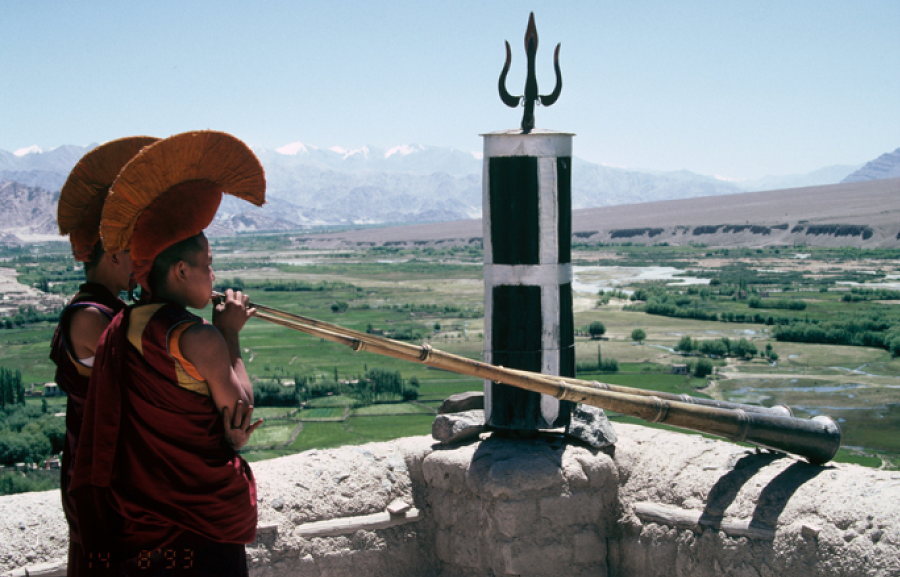 The Tibetan Monastery or “Gompa” of Spituk overlooks the Upper Indus as it flows out of Chinese Tibet and towards Baltistan in Pakistan. The Indus here is the geological dividing line between the ancient Karakorum mountains and the younger Himalayas (40+ million years old and growing: Mount Everest rises 2 inches every ten years).
The Tibetan Monastery or “Gompa” of Spituk overlooks the Upper Indus as it flows out of Chinese Tibet and towards Baltistan in Pakistan. The Indus here is the geological dividing line between the ancient Karakorum mountains and the younger Himalayas (40+ million years old and growing: Mount Everest rises 2 inches every ten years).
We’re in Indian Tibet here, a region called Ladakh where Tibetan culture flourishes freely. Wheeler Expeditions first explored Indian Tibet – including running the remote Zanskar River tributary of the Upper Indus, one the world’s most thrilling whitewater experiences – in 1992. We’ll explore it once more next year. (Glimpses of Our Breathtaking World #128 Photo ©Jack Wheeler)
THE RELIGION OF PEACE
 [This Monday’s Archive was originally published on September 11, 2003. It is still relevant today]
[This Monday’s Archive was originally published on September 11, 2003. It is still relevant today]
TTP, September 11, 2003
Earlier this week I had lunch with one of the most extraordinary human beings gracing our planet — His Holiness the Dalai Lama.
In the 102-year history of the Nobel Peace Prize, no one has deserved it more than Lhamo Dhondrub, the 14th Dalai Lama. As a man of true peace and compassion, he is unsurpassed. This is due both to his qualities as an individual and to the religion which enables him to optimize them.
From the President of the United States on down, we are subjected to claims that Islam is a “religion of peace.” To understand how absurd this claim is, just compare Islam to a real religion of peace: Buddhism.
FLASHBACK FRIDAY – SWIMMING THE HELLESPONT
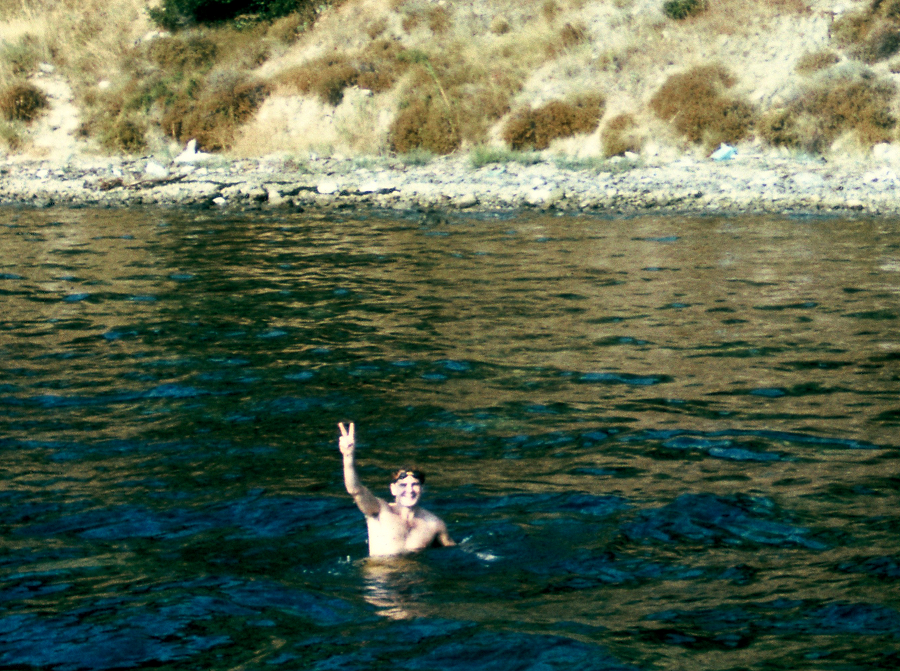 July, 1973. The Hellespont is the famous strait separating Europe from Asia, where the Black Sea after flowing through the Bosphorus at Istanbul and a widening called Marmara empties into the Aegean Sea of the Mediterranean. One of the great stories of Greek Mythology is Leander swimming the Hellespont to tryst with Hero, the woman he loved but was forbidden to see.
July, 1973. The Hellespont is the famous strait separating Europe from Asia, where the Black Sea after flowing through the Bosphorus at Istanbul and a widening called Marmara empties into the Aegean Sea of the Mediterranean. One of the great stories of Greek Mythology is Leander swimming the Hellespont to tryst with Hero, the woman he loved but was forbidden to see.
Thus he swam at night, and she lit a torch for him to swim to. One night a storm blew out the torch and the strong currents swept Leander onto the rocks to drown. So I first swam the Hellespont at night in 1960 and almost drowned myself (LIFE Magazine, Dec. 12, 1960, pp 91-94).
This was the second time, swimming from Leander’s village site of Abydos on the Asia side to Sestos, Hero’s village site on Europe’s. Here I am having reached the Sestos shore.
The Hellespont is where the Trojan War was fought, where the Persians crossed to lose against the Greeks at Marathon and Salamis, where Alexander crossed to conquer the Persian Empire. Lord Byron swam the Hellespont in 1803 to make all the legends and history a part of his life. I was determined to do the same, twice to make sure. (Glimpses of Our Breathtaking World #100 photo ©Jack Wheeler)
THE HANGING MONASTERY
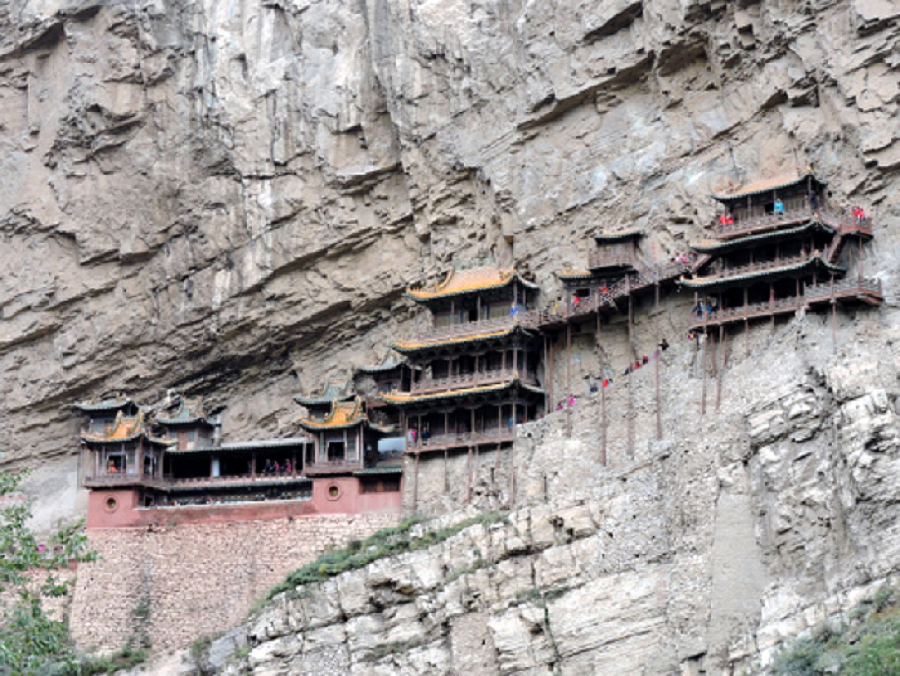 The architectural wonder of the Hanging Monastery was built on a vertical cliff face by the Tuoba people of Inner Mongolia over 1,500 years ago (in the 490s). Devout Buddhists and brilliant engineers, they defied gravity by inserting huge wooden crossbeams deep into the cliff to suspend the monastery’s temples, shrines, and monks’ living quarters, connected with bridges, corridors, and boardwalks, out into space.
The architectural wonder of the Hanging Monastery was built on a vertical cliff face by the Tuoba people of Inner Mongolia over 1,500 years ago (in the 490s). Devout Buddhists and brilliant engineers, they defied gravity by inserting huge wooden crossbeams deep into the cliff to suspend the monastery’s temples, shrines, and monks’ living quarters, connected with bridges, corridors, and boardwalks, out into space.
Liao Mongols in the 900s rebuilt and sustained it, and it has been carefully refurbished and restored in the centuries since. While it remains primarily Buddhist with statues and depictions of Sakyamuni (the historical Buddha of 5th century BC) and Maitreya (the future Buddha), the monks welcome reverence to Taoism and its founder Lao Tzu (4th century BC), as well as Confucius (551-479 BC). Thus you also see shrines and statues of them like nowhere else.
It is a unique and inspiring experience to be here. We’ll be here again in our next exploration of Inner Mongolia sometime soon. ((Glimpses of Our Breathtaking World #116 photo ©Jack Wheeler)
THE ARIRANG MASS GAMES IN NORTH KOREA
 The spectacle takes place in the fall at the May Day Stadium in Pyongyang. I attended in 2010 and 2012. It has to be seen to be believed. You’re looking at 10,000 dancers, acrobats and performers on the stadium floor. The background screen of a rising sun and Korean letters is a “card stunt,” 30,000 students holding colored cards composing it.
The spectacle takes place in the fall at the May Day Stadium in Pyongyang. I attended in 2010 and 2012. It has to be seen to be believed. You’re looking at 10,000 dancers, acrobats and performers on the stadium floor. The background screen of a rising sun and Korean letters is a “card stunt,” 30,000 students holding colored cards composing it.
The number “65” is for the 65th anniversary of the surrender of Imperial Japan in World War II (August 15, 1945 – I took this photo in 2010), their Liberation Day (our V-J Day). The snowy mountain depicted below the 65 is Mount Paekdu, where all North Koreans are taught their country’s founder Kim Il-sung defeated the Japanese and won the war (he was actually at a Soviet army camp near Khabarovsk, Siberia at the time).
They are never taught a word about the events a few days prior to their Liberation Day (i.e. Hiroshima and Nagasaki), nor to whom the Japanese surrendered. Hands down, NorkLand is the world’s most bizarre country. (Glimpses of Our Breathtaking World #88 Photo ©Jack Wheeler)
GRAND ESCALANTE STAIRCASE
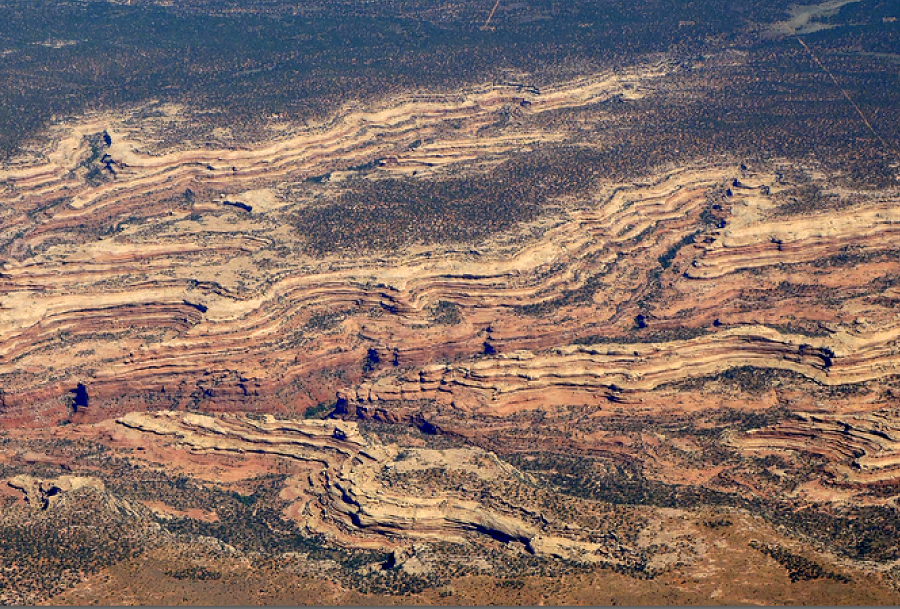 As you can see, this place is aptly named. It is simply phantasmagorical – nature on LSD. Then again, so much of southern Utah is too, for close by Escalante are the Vermillion Cliffs, Capitol Reef, Bryce Canyon, Zion Canyon, Monument Valley and a lot more.
As you can see, this place is aptly named. It is simply phantasmagorical – nature on LSD. Then again, so much of southern Utah is too, for close by Escalante are the Vermillion Cliffs, Capitol Reef, Bryce Canyon, Zion Canyon, Monument Valley and a lot more.
The entire area is Navaho country, so it is no surprise their native religion is based on peyote, a cactus containing the hallucinogen, mescaline, with the Navaho belief that nature surrounding them was designed by the Peyote Bird.
However, it is not necessary to take any hallucinogen to achieve a sense of ecstasy being here – just a deep appreciation of what a wondrous world – a breathtaking world – it is that we are all privileged to be alive in. (Glimpses of Our Breathtaking World #180 photo ©Jack Wheeler)
THE WORLD’S MOST UNIQUE BIRD
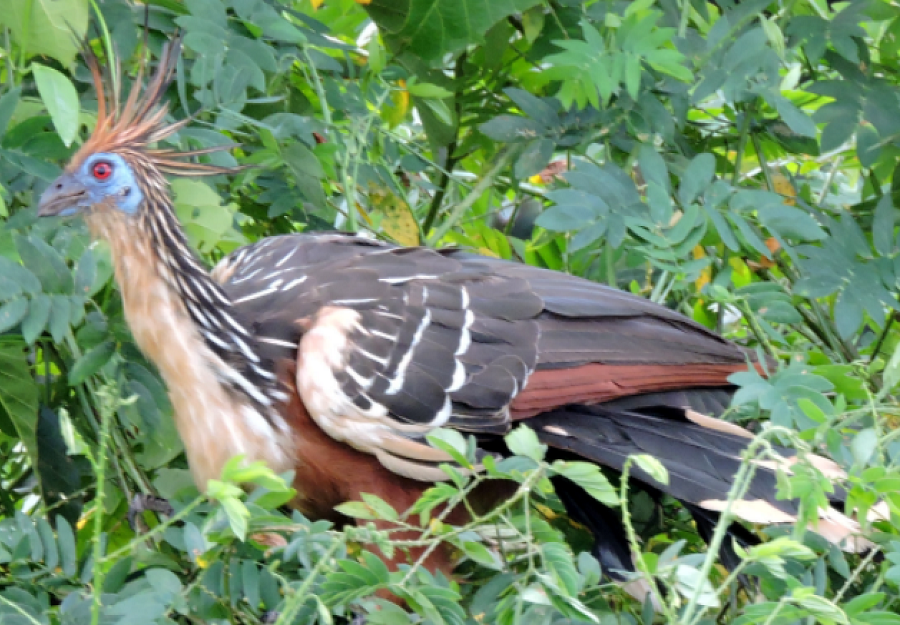 This is a Hoatzin. I took this picture in the Amazon jungles of Colombia, its native habitat. It has no genetic relationship to any other bird, and thus has its own family, the Opisthocomidae, and its own suborder, the Opisthocomi. Extensive DNA-sequencing demonstrates that “the hoatzin is the last surviving member of a bird line that branched off in its own direction 64 million years ago, shortly after the extinction event that killed the non-avian dinosaurs.”
This is a Hoatzin. I took this picture in the Amazon jungles of Colombia, its native habitat. It has no genetic relationship to any other bird, and thus has its own family, the Opisthocomidae, and its own suborder, the Opisthocomi. Extensive DNA-sequencing demonstrates that “the hoatzin is the last surviving member of a bird line that branched off in its own direction 64 million years ago, shortly after the extinction event that killed the non-avian dinosaurs.”
The Hoatzin is the Dinosaur Bird, the only bird on earth directly descended from the dinosaurs. It makes weird noises – grunts, hisses, groans and croaks – no melodious birdsongs. It emits an awful smell due to its fermentation digestive system, and tastes just as awful so no one hunts it for food. Yet it is distinctively pretty in a hyper-funky way. Spend enough time exploring the Amazon, and you may be lucky to see one. (Glimpses of Our Breathtaking World #186 photo ©Jack Wheeler)
AIKIDO AND THE GLOWARMER FLEA
[This week’s Archive was originally published on May 7, 2007. I had some fun with it at the start, but it ends with a fascinating theory by two professors of astrophysics. Since Warmism is a secular religion invulnerable to real facts and science, it has since been ignored, but it’s useful to bring it to attention now. Enjoy.]
TTP, May 9, 2007
We're going for a wild ride here, starting on a log floating down a river, then go on a fling through the galaxy. On the way, we'll examine the extinction of the dinosaurs. We'll end up applying aikido to astrophysics as a way to de-subsidize the glowarmers.
Glowarmers – those who believe in the religion of Man-Made ("Anthropogenic") Global warming – argue that:
- The earth's climate is getting dangerously warmer due to "greenhouse gases" that hold heat in the atmosphere so it can't escape into frigid space…
- The greenhouse gas primarily responsible for this "greenhouse effect" causing global warming is carbon dioxide…
- Human energy production and consumption (e.g., coal-fired power plants, internal combustion engines) is the primary emitter of the additional carbon dioxide causing the global warming…
- Thus the solution to global warming is the drastic reduction of human carbon dioxide emissions.
So lunatic enormous that the glowarmers' egos are like the ultimate joke example of egomania, the flea with a hard-on.
FLASHBACK FRIDAY JACKSON AT NAMCHE BARWA
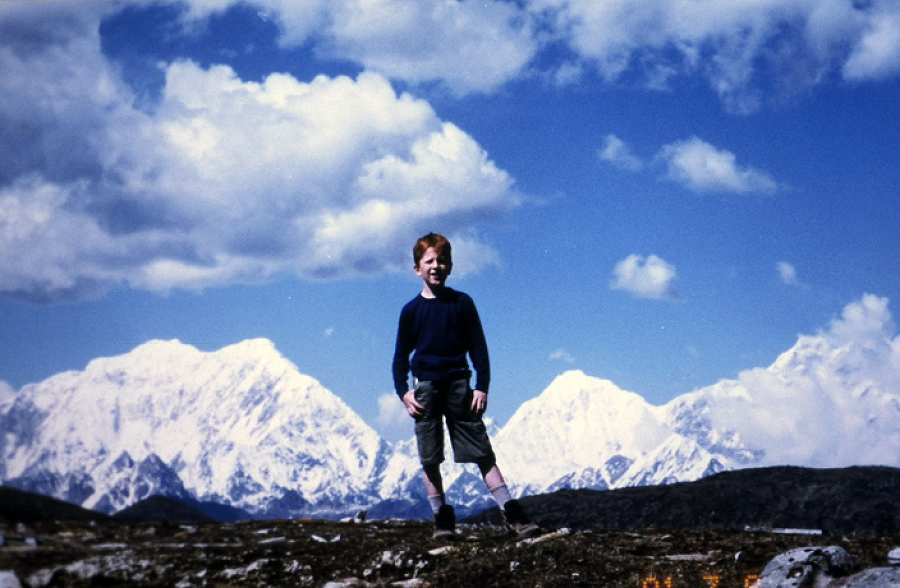 In the summer of 2001, I led an overland expedition of 2,500 kilometers across Eastern Tibet, traversing by foot the “Great River Trenches of Asia,” over the 15,000’ Si-la pass between the Salween and Mekong Rivers, thence to the Upper Yangtze by 4WD following it to near its source, onto Lhasa, capital of Tibet.
In the summer of 2001, I led an overland expedition of 2,500 kilometers across Eastern Tibet, traversing by foot the “Great River Trenches of Asia,” over the 15,000’ Si-la pass between the Salween and Mekong Rivers, thence to the Upper Yangtze by 4WD following it to near its source, onto Lhasa, capital of Tibet.
Enroute we stopped at incredibly remote and rarely seen Namche Barwa (7,782m/25,531ft), the eastern terminus of the Himalayas, which run in a 1,600 mile-long arc from here in Tibet through Nepal, Northwest India, to end at the western terminus of Nanga Parbat in Pakistan.
At nine years old, Jackson handled this like a trooper. What a rewarding thrill it is to have a great adventure with your children. (Glimpses of Our Breathtaking World #277 photo ©Jack Wheeler)
THE RIGALEIRA INITIATION WELL
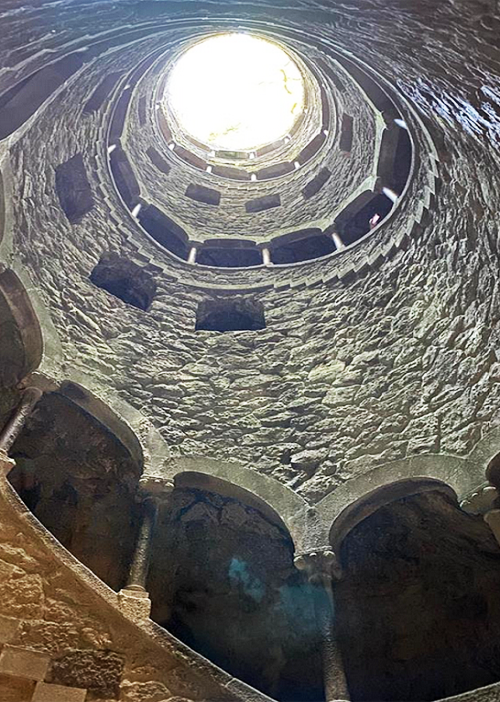 Do an internet search for “25 Most Mysterious Places on Earth” or similar listing, and almost always the Regaleira Initiation Well in Sintra, Portugal will be there. Since the photo is almost always looking from the top down, I thought you might like to see one from the bottom up, which is just as dramatic.
Do an internet search for “25 Most Mysterious Places on Earth” or similar listing, and almost always the Regaleira Initiation Well in Sintra, Portugal will be there. Since the photo is almost always looking from the top down, I thought you might like to see one from the bottom up, which is just as dramatic.
The Regaleira is a spectacular Gothic mansion with acres of gorgeous gardens built by a 19th century Portuguese-Brazilian millionaire, Carvalho Monteiro (1848-1920). I love it that his exotic eccentric extravaganza, his Regaleira Palace, was built by private capitalist with his own money – not some feudal king with money extracted from the peasantry.
I took this picture in 2021 with fellow TTPers on our Portugal Exploration. Portugal really is a land of wonders, which I hope you’ll someday experience yourself. (Glimpses of Our Breathtaking World #167 photo ©Jack Wheeler)
THE MOTHER LEATHERBACK
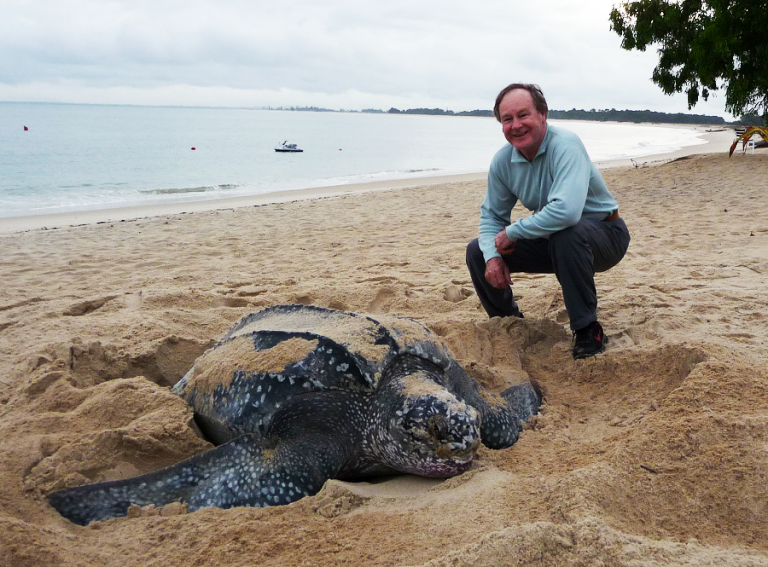 The leatherneck sea turtle is the world’s largest turtle, weighing up to 1500 pounds. This female was about half that. They have an enormous range, all the way from the North Sea to South Africa in the Atlantic, spending their lives at sea eating jellyfish – except when a female comes ashore to her hatching beach and bury her clutch of eggs in the sand above high tide.
The leatherneck sea turtle is the world’s largest turtle, weighing up to 1500 pounds. This female was about half that. They have an enormous range, all the way from the North Sea to South Africa in the Atlantic, spending their lives at sea eating jellyfish – except when a female comes ashore to her hatching beach and bury her clutch of eggs in the sand above high tide.
Dropping several dozen glistening white golfball-size eggs into a depression scooped out with her flippers, she covers them up with sand, and heads back to sea, never to see them again. More than two months later, the born hatchlings dig out of the sand and wiggle their way into the sea, where the lucky ones survive.
I was able to watch this mommy’s entire egg-birthing process at dawn on a remote beach in the West African country of Gabon. It was such a privilege to witness an act of elemental nature by such an extraordinary creature. (Glimpses of Our Breathtaking World #127 Photo ©Jack Wheeler)
THE BORU HARP
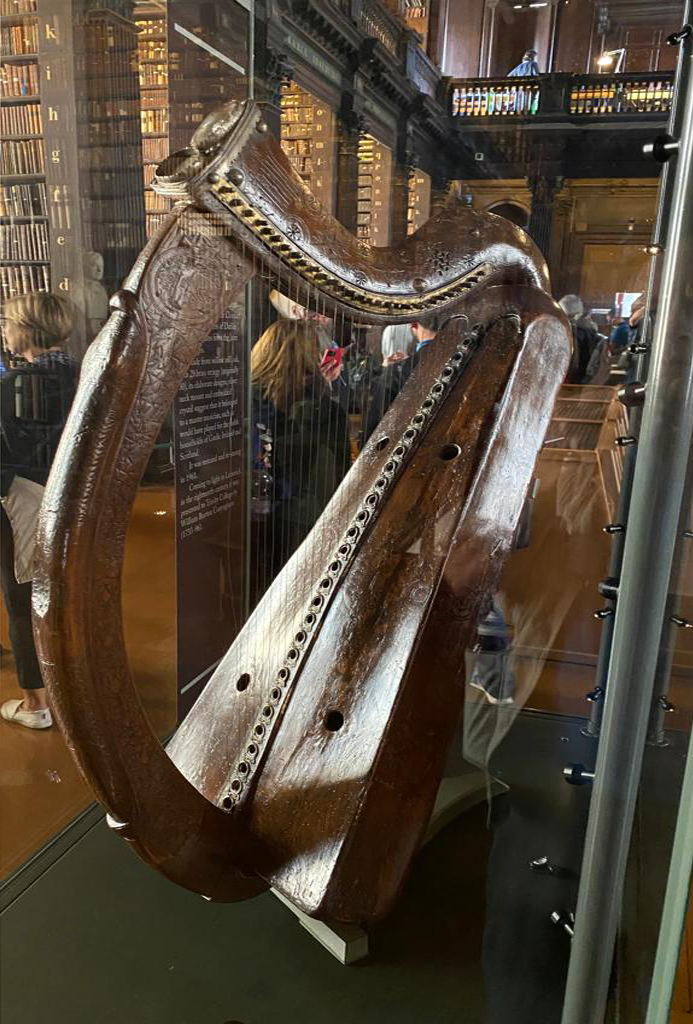 The Boru Harp, attributed to the one and only High King of the entire island of Ireland, Brian Boru (941-1014), is the only musical instrument that is the national symbol of a country - the Republic of Ireland. It is also on the label of Guinness beer. Beautifully and exquisitely made, the Boru Harp is on display in the famous Long Room of the Trinity College Library in Dublin. You’ll experience a sense of awe when you see it for yourself. (Glimpses of Our Breathtaking World #219 photo ©Jack Wheeler)
The Boru Harp, attributed to the one and only High King of the entire island of Ireland, Brian Boru (941-1014), is the only musical instrument that is the national symbol of a country - the Republic of Ireland. It is also on the label of Guinness beer. Beautifully and exquisitely made, the Boru Harp is on display in the famous Long Room of the Trinity College Library in Dublin. You’ll experience a sense of awe when you see it for yourself. (Glimpses of Our Breathtaking World #219 photo ©Jack Wheeler)
SKARA BRAE
North of Scotland are the Orkney Islands. On a windswept bluff above the North Atlantic, archaeologists have unearthed an intact Neolithic village of farmers and cattle herders that’s 5,000 years old (3200 BC) – centuries older than the Pyramids of Egypt. Their homes had beds, chairs, cupboards, flush toilets, running water, cozy, warm, and comfortable.
What you see here is just one section of the village. What I found particularly interesting was this sign at the entrance to the site.
These villagers enjoyed a warmer climate than today, more fertile land. Skara Brae is a 5,000 year-old refutation of the Global Warming Hoax. If you ever get to Scotland, be sure the Orkneys are on your itinerary. Skara Brae is only one of the places you’ll find fascinating. (Glimpses of Our Breathtaking World #210 photo ©Jack Wheeler)
PRETENDING TO BE HAPPY
[This Monday’s Archive was originally published on May 13, 2005. These days, we all could use a way to “pretend” to be happy, to transform the seeming mundane into an experience of magical gratitude. I hope you find it useful. Let me know if it does.]
TTP, May 13, 2005
Last week was the 13th birthday of my youngest son, Jackson. One evening a few days before, I was engrossed in writing on the computer when my wife reminded me it was Jackson’s bedtime. He was in bed reading, waiting for me to kiss him goodnight.
As I walked down the hall towards his room, my brain was filled with thoughts about the article I was working on. I was on autopilot and all I could think about was what I would write when I got back on the computer.
For some reason, I stopped and stood still. Somehow, an extraneous thought had popped into my consciousness from nowhere.


